Implementing Green Mobility through Transport Engineering Concepts
VerifiedAdded on 2020/11/23
|14
|4422
|344
Essay
AI Summary
This technical paper essay delves into the implementation of transport engineering concepts to promote green mobility in urban scenarios, addressing pressing environmental issues like global warming, poor air quality, and traffic congestion. It highlights the effective use of resources to mitigate the impacts of urbanization, motorization, and unsustainable practices, emphasizing the importance of systematic techniques for congestion-free movement of people, goods, and services. The essay explores the strong connection between transportation and economic development, examining the role of transport engineering in fostering green mobility, including practical implementations, challenges, and future implications. It discusses the significance of green mobility, its benefits, such as reduced pollution and improved health, and its role in sustainable economic development. Furthermore, it touches upon the onset for sustainability in urban areas, the impact of transport engineering on urban design, and the importance of government regulations and investments in promoting green mobility, referencing examples such as the Mobility Index of Sustainable Cities and the United Nations Climate Change Conference (COP24).
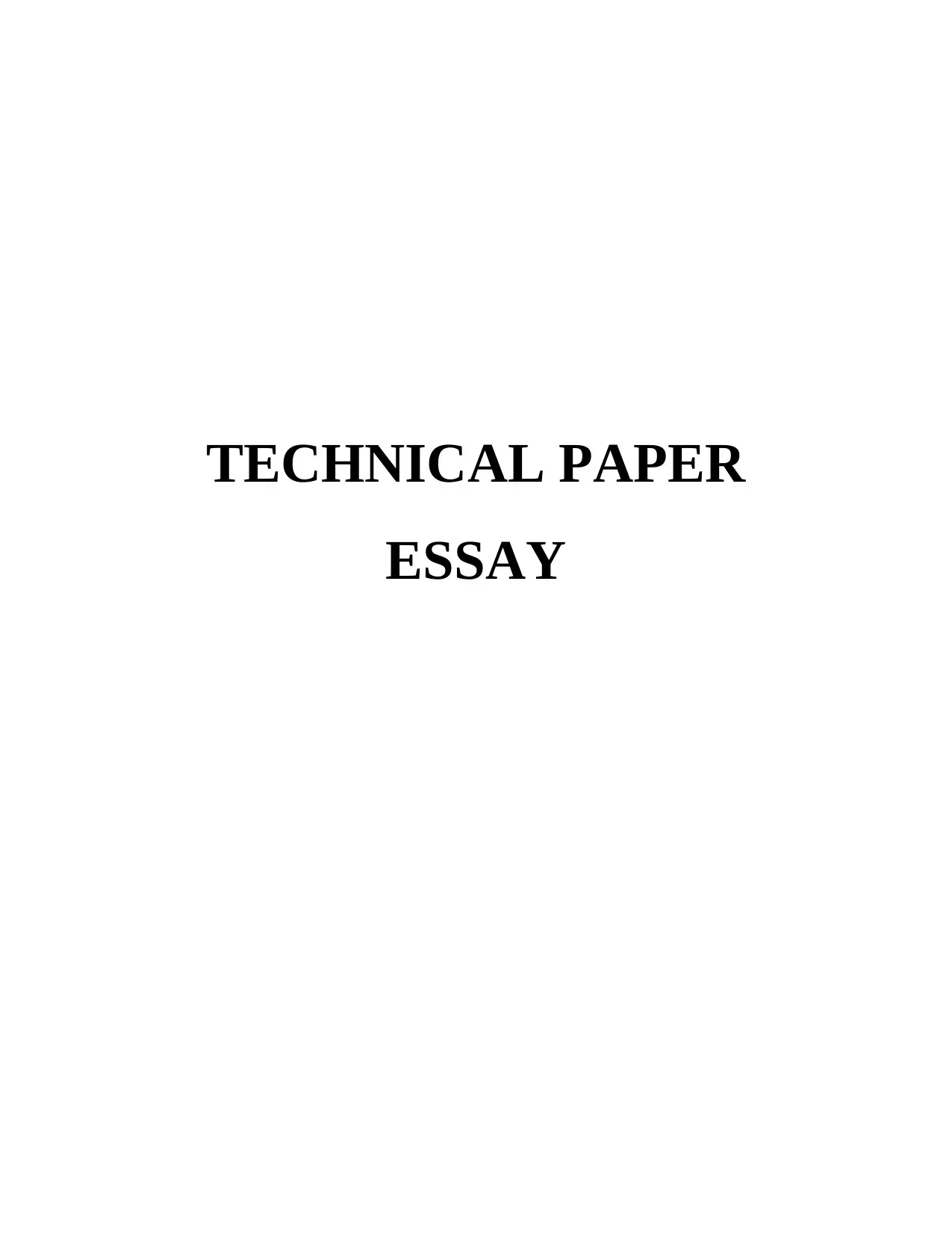
TECHNICAL PAPER
ESSAY
ESSAY
Paraphrase This Document
Need a fresh take? Get an instant paraphrase of this document with our AI Paraphraser
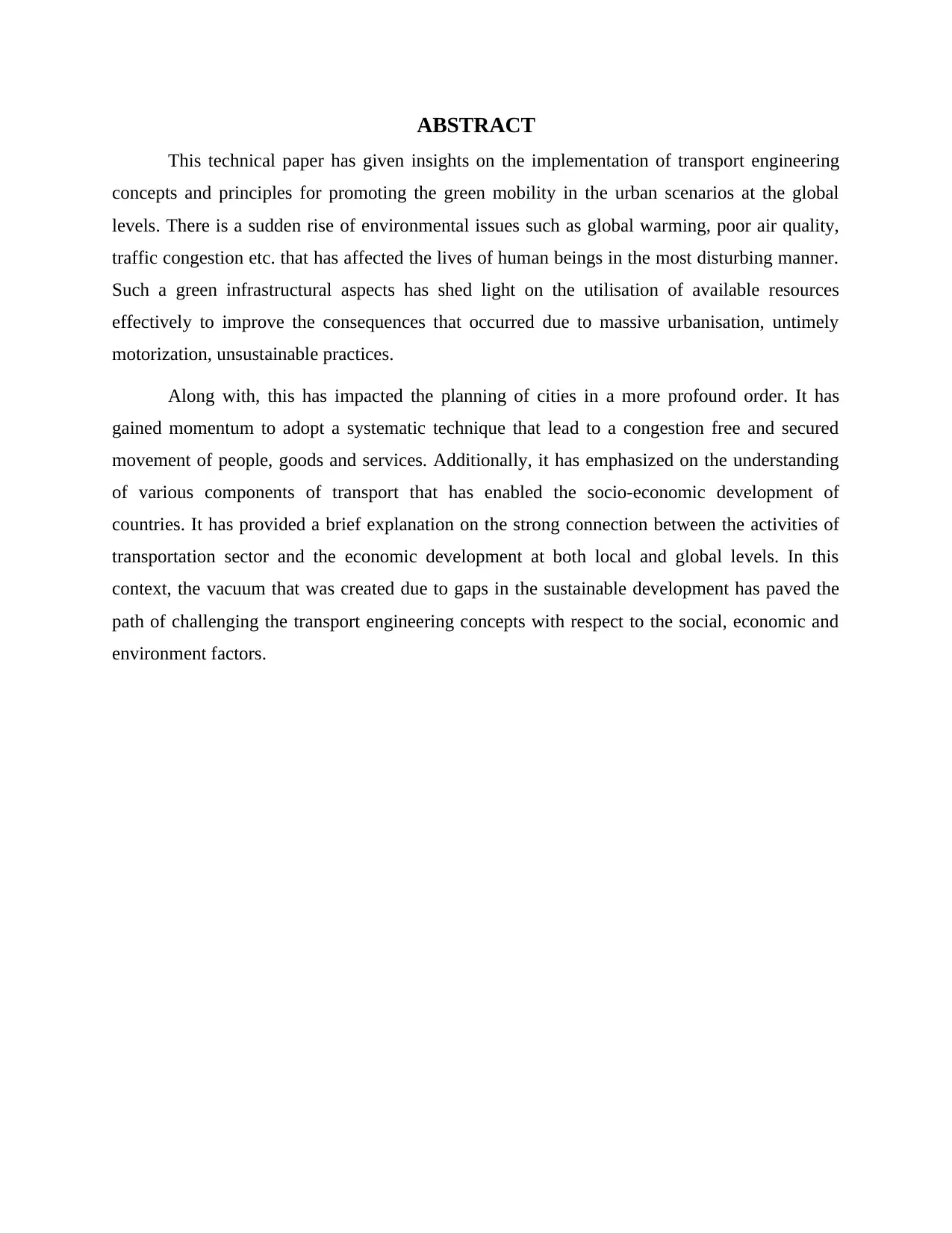
ABSTRACT
This technical paper has given insights on the implementation of transport engineering
concepts and principles for promoting the green mobility in the urban scenarios at the global
levels. There is a sudden rise of environmental issues such as global warming, poor air quality,
traffic congestion etc. that has affected the lives of human beings in the most disturbing manner.
Such a green infrastructural aspects has shed light on the utilisation of available resources
effectively to improve the consequences that occurred due to massive urbanisation, untimely
motorization, unsustainable practices.
Along with, this has impacted the planning of cities in a more profound order. It has
gained momentum to adopt a systematic technique that lead to a congestion free and secured
movement of people, goods and services. Additionally, it has emphasized on the understanding
of various components of transport that has enabled the socio-economic development of
countries. It has provided a brief explanation on the strong connection between the activities of
transportation sector and the economic development at both local and global levels. In this
context, the vacuum that was created due to gaps in the sustainable development has paved the
path of challenging the transport engineering concepts with respect to the social, economic and
environment factors.
This technical paper has given insights on the implementation of transport engineering
concepts and principles for promoting the green mobility in the urban scenarios at the global
levels. There is a sudden rise of environmental issues such as global warming, poor air quality,
traffic congestion etc. that has affected the lives of human beings in the most disturbing manner.
Such a green infrastructural aspects has shed light on the utilisation of available resources
effectively to improve the consequences that occurred due to massive urbanisation, untimely
motorization, unsustainable practices.
Along with, this has impacted the planning of cities in a more profound order. It has
gained momentum to adopt a systematic technique that lead to a congestion free and secured
movement of people, goods and services. Additionally, it has emphasized on the understanding
of various components of transport that has enabled the socio-economic development of
countries. It has provided a brief explanation on the strong connection between the activities of
transportation sector and the economic development at both local and global levels. In this
context, the vacuum that was created due to gaps in the sustainable development has paved the
path of challenging the transport engineering concepts with respect to the social, economic and
environment factors.
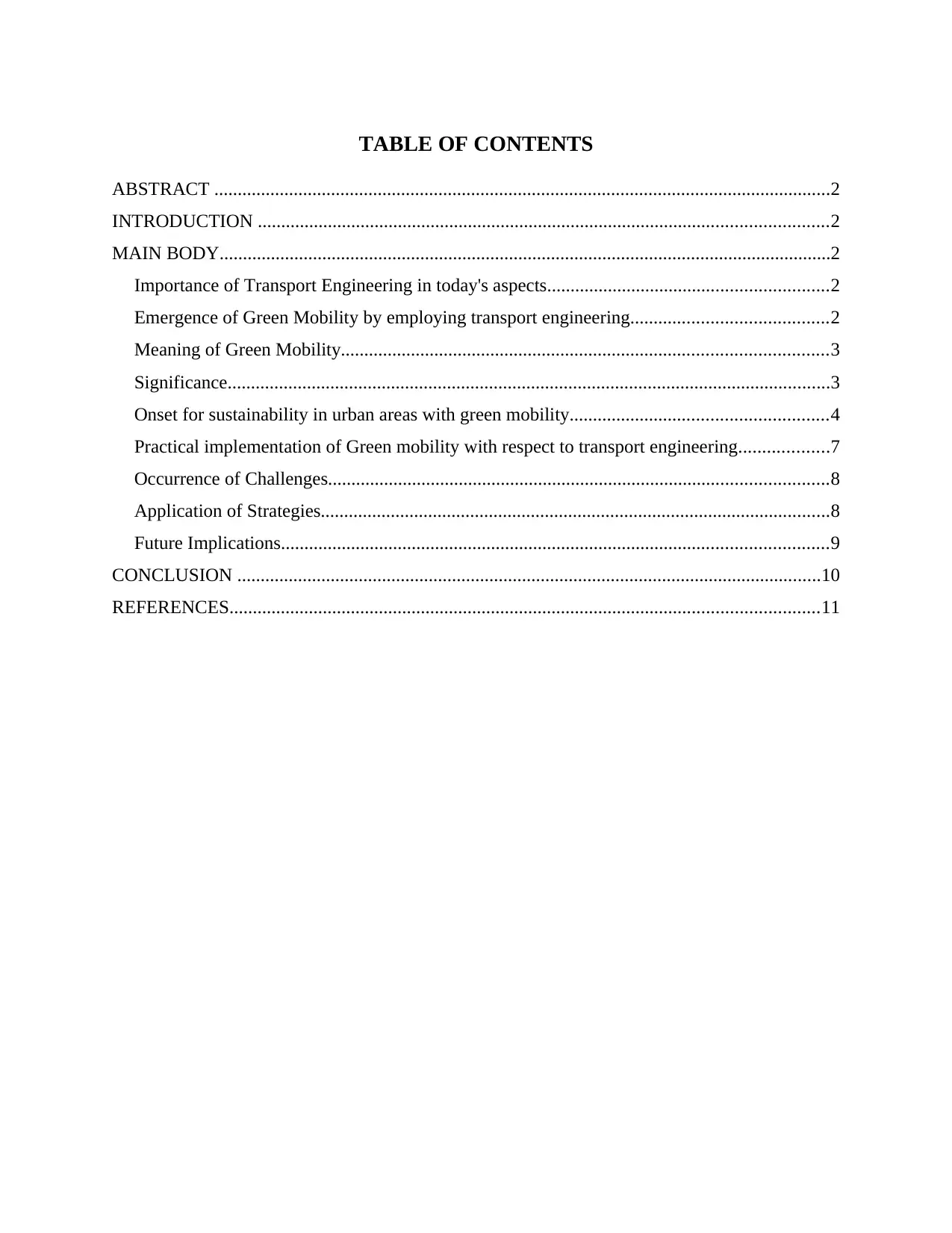
TABLE OF CONTENTS
ABSTRACT ....................................................................................................................................2
INTRODUCTION ..........................................................................................................................2
MAIN BODY...................................................................................................................................2
Importance of Transport Engineering in today's aspects............................................................2
Emergence of Green Mobility by employing transport engineering..........................................2
Meaning of Green Mobility........................................................................................................3
Significance.................................................................................................................................3
Onset for sustainability in urban areas with green mobility.......................................................4
Practical implementation of Green mobility with respect to transport engineering...................7
Occurrence of Challenges...........................................................................................................8
Application of Strategies.............................................................................................................8
Future Implications.....................................................................................................................9
CONCLUSION .............................................................................................................................10
REFERENCES..............................................................................................................................11
ABSTRACT ....................................................................................................................................2
INTRODUCTION ..........................................................................................................................2
MAIN BODY...................................................................................................................................2
Importance of Transport Engineering in today's aspects............................................................2
Emergence of Green Mobility by employing transport engineering..........................................2
Meaning of Green Mobility........................................................................................................3
Significance.................................................................................................................................3
Onset for sustainability in urban areas with green mobility.......................................................4
Practical implementation of Green mobility with respect to transport engineering...................7
Occurrence of Challenges...........................................................................................................8
Application of Strategies.............................................................................................................8
Future Implications.....................................................................................................................9
CONCLUSION .............................................................................................................................10
REFERENCES..............................................................................................................................11
⊘ This is a preview!⊘
Do you want full access?
Subscribe today to unlock all pages.

Trusted by 1+ million students worldwide
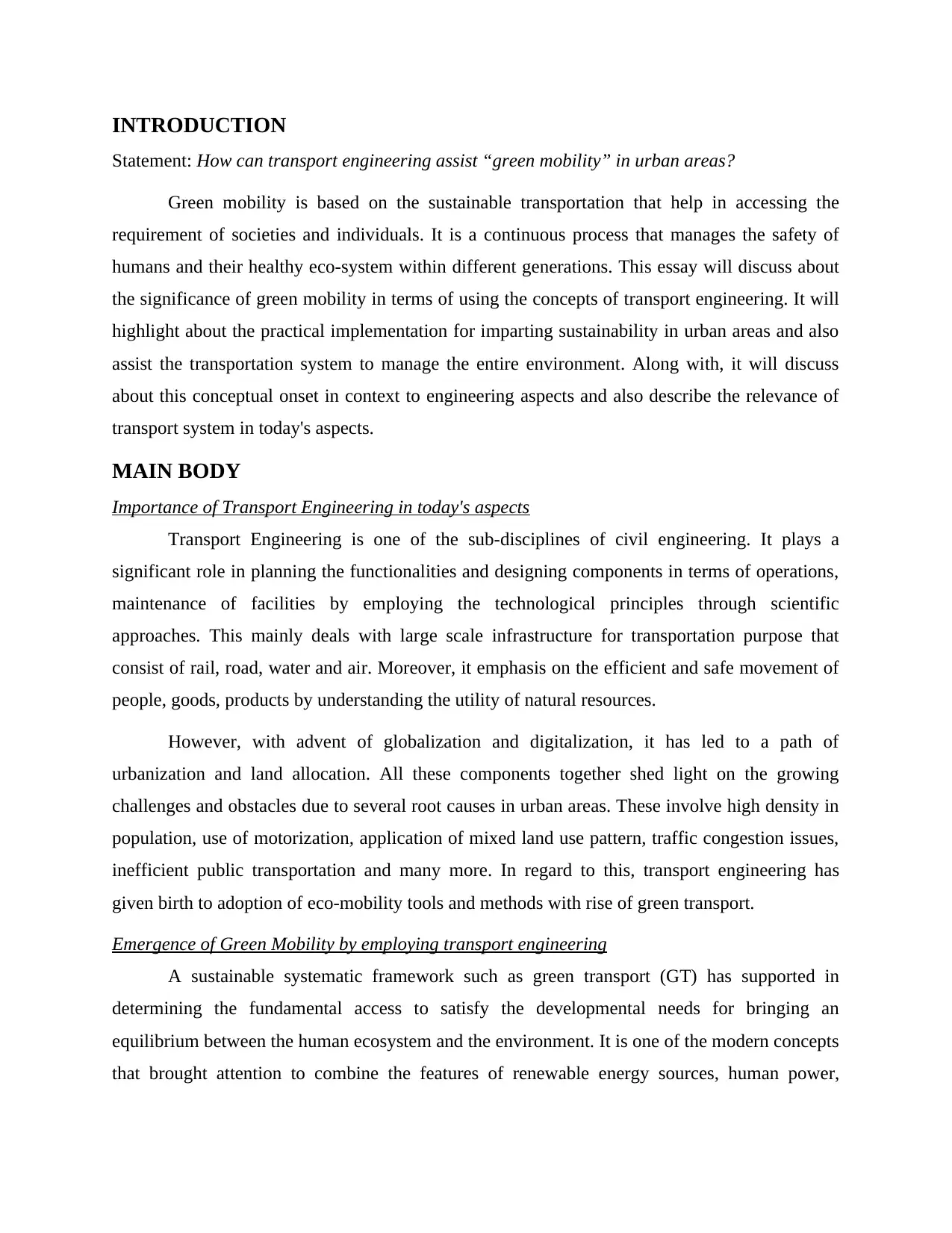
INTRODUCTION
Statement: How can transport engineering assist “green mobility” in urban areas?
Green mobility is based on the sustainable transportation that help in accessing the
requirement of societies and individuals. It is a continuous process that manages the safety of
humans and their healthy eco-system within different generations. This essay will discuss about
the significance of green mobility in terms of using the concepts of transport engineering. It will
highlight about the practical implementation for imparting sustainability in urban areas and also
assist the transportation system to manage the entire environment. Along with, it will discuss
about this conceptual onset in context to engineering aspects and also describe the relevance of
transport system in today's aspects.
MAIN BODY
Importance of Transport Engineering in today's aspects
Transport Engineering is one of the sub-disciplines of civil engineering. It plays a
significant role in planning the functionalities and designing components in terms of operations,
maintenance of facilities by employing the technological principles through scientific
approaches. This mainly deals with large scale infrastructure for transportation purpose that
consist of rail, road, water and air. Moreover, it emphasis on the efficient and safe movement of
people, goods, products by understanding the utility of natural resources.
However, with advent of globalization and digitalization, it has led to a path of
urbanization and land allocation. All these components together shed light on the growing
challenges and obstacles due to several root causes in urban areas. These involve high density in
population, use of motorization, application of mixed land use pattern, traffic congestion issues,
inefficient public transportation and many more. In regard to this, transport engineering has
given birth to adoption of eco-mobility tools and methods with rise of green transport.
Emergence of Green Mobility by employing transport engineering
A sustainable systematic framework such as green transport (GT) has supported in
determining the fundamental access to satisfy the developmental needs for bringing an
equilibrium between the human ecosystem and the environment. It is one of the modern concepts
that brought attention to combine the features of renewable energy sources, human power,
Statement: How can transport engineering assist “green mobility” in urban areas?
Green mobility is based on the sustainable transportation that help in accessing the
requirement of societies and individuals. It is a continuous process that manages the safety of
humans and their healthy eco-system within different generations. This essay will discuss about
the significance of green mobility in terms of using the concepts of transport engineering. It will
highlight about the practical implementation for imparting sustainability in urban areas and also
assist the transportation system to manage the entire environment. Along with, it will discuss
about this conceptual onset in context to engineering aspects and also describe the relevance of
transport system in today's aspects.
MAIN BODY
Importance of Transport Engineering in today's aspects
Transport Engineering is one of the sub-disciplines of civil engineering. It plays a
significant role in planning the functionalities and designing components in terms of operations,
maintenance of facilities by employing the technological principles through scientific
approaches. This mainly deals with large scale infrastructure for transportation purpose that
consist of rail, road, water and air. Moreover, it emphasis on the efficient and safe movement of
people, goods, products by understanding the utility of natural resources.
However, with advent of globalization and digitalization, it has led to a path of
urbanization and land allocation. All these components together shed light on the growing
challenges and obstacles due to several root causes in urban areas. These involve high density in
population, use of motorization, application of mixed land use pattern, traffic congestion issues,
inefficient public transportation and many more. In regard to this, transport engineering has
given birth to adoption of eco-mobility tools and methods with rise of green transport.
Emergence of Green Mobility by employing transport engineering
A sustainable systematic framework such as green transport (GT) has supported in
determining the fundamental access to satisfy the developmental needs for bringing an
equilibrium between the human ecosystem and the environment. It is one of the modern concepts
that brought attention to combine the features of renewable energy sources, human power,
Paraphrase This Document
Need a fresh take? Get an instant paraphrase of this document with our AI Paraphraser
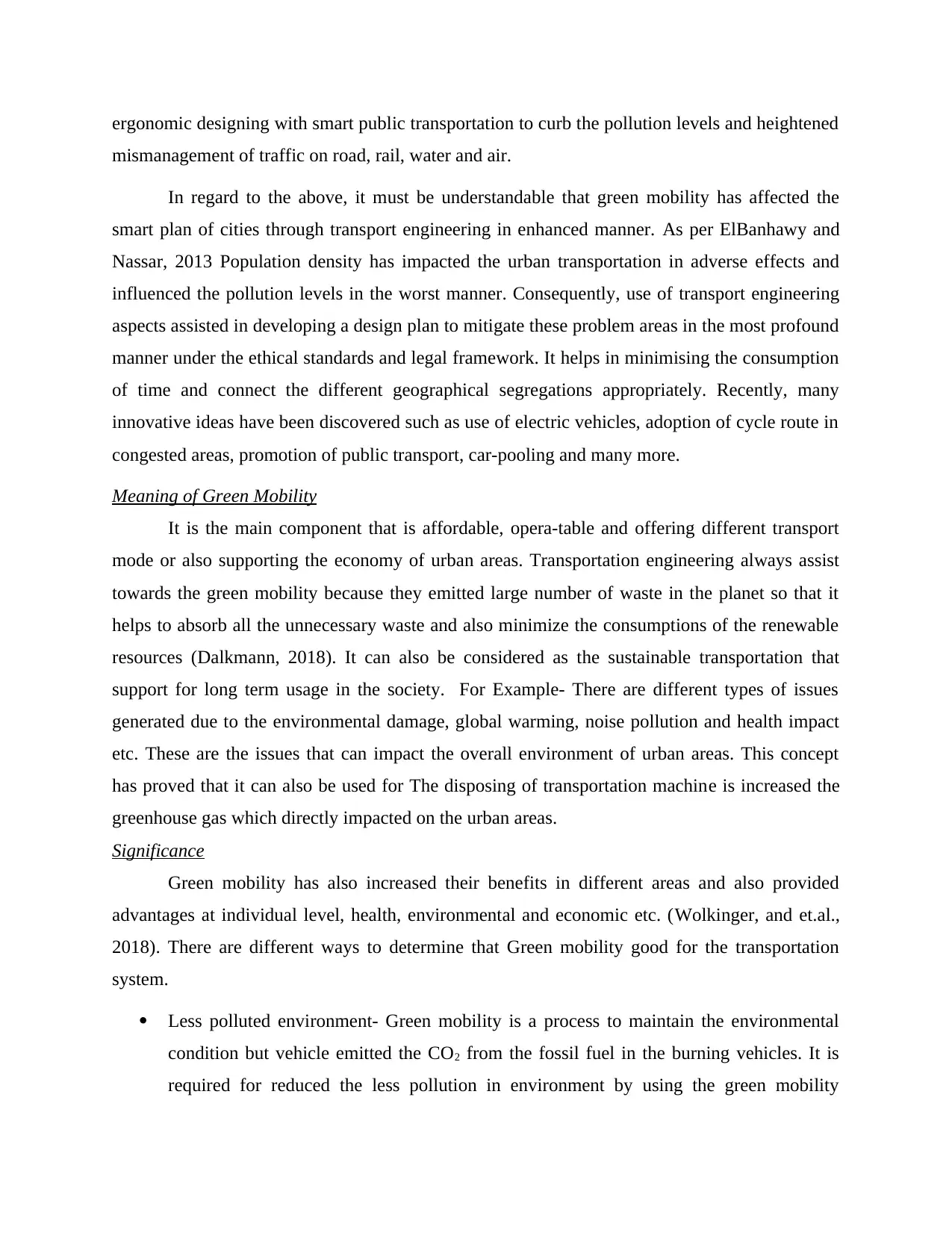
ergonomic designing with smart public transportation to curb the pollution levels and heightened
mismanagement of traffic on road, rail, water and air.
In regard to the above, it must be understandable that green mobility has affected the
smart plan of cities through transport engineering in enhanced manner. As per ElBanhawy and
Nassar, 2013 Population density has impacted the urban transportation in adverse effects and
influenced the pollution levels in the worst manner. Consequently, use of transport engineering
aspects assisted in developing a design plan to mitigate these problem areas in the most profound
manner under the ethical standards and legal framework. It helps in minimising the consumption
of time and connect the different geographical segregations appropriately. Recently, many
innovative ideas have been discovered such as use of electric vehicles, adoption of cycle route in
congested areas, promotion of public transport, car-pooling and many more.
Meaning of Green Mobility
It is the main component that is affordable, opera-table and offering different transport
mode or also supporting the economy of urban areas. Transportation engineering always assist
towards the green mobility because they emitted large number of waste in the planet so that it
helps to absorb all the unnecessary waste and also minimize the consumptions of the renewable
resources (Dalkmann, 2018). It can also be considered as the sustainable transportation that
support for long term usage in the society. For Example- There are different types of issues
generated due to the environmental damage, global warming, noise pollution and health impact
etc. These are the issues that can impact the overall environment of urban areas. This concept
has proved that it can also be used for The disposing of transportation machine is increased the
greenhouse gas which directly impacted on the urban areas.
Significance
Green mobility has also increased their benefits in different areas and also provided
advantages at individual level, health, environmental and economic etc. (Wolkinger, and et.al.,
2018). There are different ways to determine that Green mobility good for the transportation
system.
Less polluted environment- Green mobility is a process to maintain the environmental
condition but vehicle emitted the CO2 from the fossil fuel in the burning vehicles. It is
required for reduced the less pollution in environment by using the green mobility
mismanagement of traffic on road, rail, water and air.
In regard to the above, it must be understandable that green mobility has affected the
smart plan of cities through transport engineering in enhanced manner. As per ElBanhawy and
Nassar, 2013 Population density has impacted the urban transportation in adverse effects and
influenced the pollution levels in the worst manner. Consequently, use of transport engineering
aspects assisted in developing a design plan to mitigate these problem areas in the most profound
manner under the ethical standards and legal framework. It helps in minimising the consumption
of time and connect the different geographical segregations appropriately. Recently, many
innovative ideas have been discovered such as use of electric vehicles, adoption of cycle route in
congested areas, promotion of public transport, car-pooling and many more.
Meaning of Green Mobility
It is the main component that is affordable, opera-table and offering different transport
mode or also supporting the economy of urban areas. Transportation engineering always assist
towards the green mobility because they emitted large number of waste in the planet so that it
helps to absorb all the unnecessary waste and also minimize the consumptions of the renewable
resources (Dalkmann, 2018). It can also be considered as the sustainable transportation that
support for long term usage in the society. For Example- There are different types of issues
generated due to the environmental damage, global warming, noise pollution and health impact
etc. These are the issues that can impact the overall environment of urban areas. This concept
has proved that it can also be used for The disposing of transportation machine is increased the
greenhouse gas which directly impacted on the urban areas.
Significance
Green mobility has also increased their benefits in different areas and also provided
advantages at individual level, health, environmental and economic etc. (Wolkinger, and et.al.,
2018). There are different ways to determine that Green mobility good for the transportation
system.
Less polluted environment- Green mobility is a process to maintain the environmental
condition but vehicle emitted the CO2 from the fossil fuel in the burning vehicles. It is
required for reduced the less pollution in environment by using the green mobility
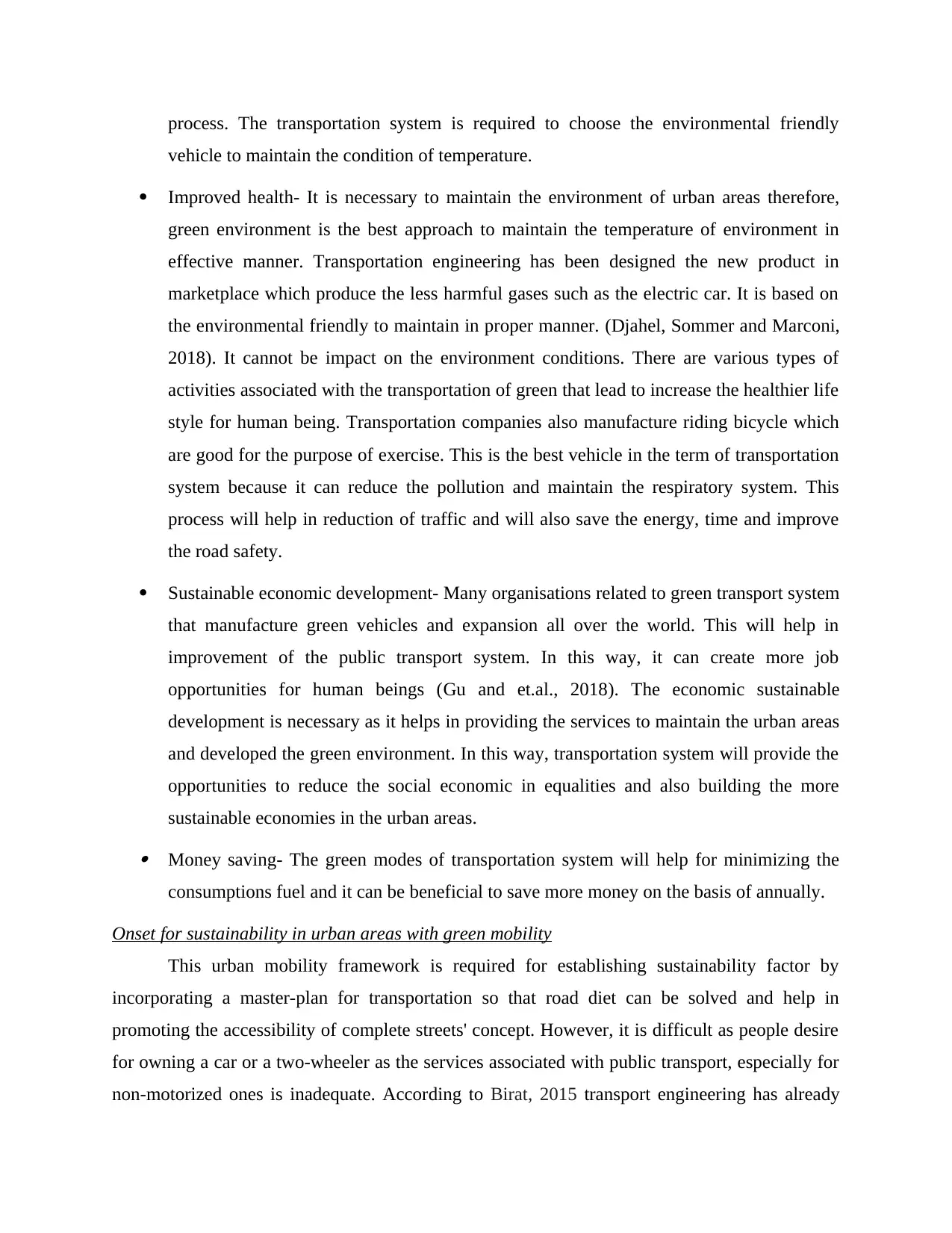
process. The transportation system is required to choose the environmental friendly
vehicle to maintain the condition of temperature.
Improved health- It is necessary to maintain the environment of urban areas therefore,
green environment is the best approach to maintain the temperature of environment in
effective manner. Transportation engineering has been designed the new product in
marketplace which produce the less harmful gases such as the electric car. It is based on
the environmental friendly to maintain in proper manner. (Djahel, Sommer and Marconi,
2018). It cannot be impact on the environment conditions. There are various types of
activities associated with the transportation of green that lead to increase the healthier life
style for human being. Transportation companies also manufacture riding bicycle which
are good for the purpose of exercise. This is the best vehicle in the term of transportation
system because it can reduce the pollution and maintain the respiratory system. This
process will help in reduction of traffic and will also save the energy, time and improve
the road safety.
Sustainable economic development- Many organisations related to green transport system
that manufacture green vehicles and expansion all over the world. This will help in
improvement of the public transport system. In this way, it can create more job
opportunities for human beings (Gu and et.al., 2018). The economic sustainable
development is necessary as it helps in providing the services to maintain the urban areas
and developed the green environment. In this way, transportation system will provide the
opportunities to reduce the social economic in equalities and also building the more
sustainable economies in the urban areas. Money saving- The green modes of transportation system will help for minimizing the
consumptions fuel and it can be beneficial to save more money on the basis of annually.
Onset for sustainability in urban areas with green mobility
This urban mobility framework is required for establishing sustainability factor by
incorporating a master-plan for transportation so that road diet can be solved and help in
promoting the accessibility of complete streets' concept. However, it is difficult as people desire
for owning a car or a two-wheeler as the services associated with public transport, especially for
non-motorized ones is inadequate. According to Birat, 2015 transport engineering has already
vehicle to maintain the condition of temperature.
Improved health- It is necessary to maintain the environment of urban areas therefore,
green environment is the best approach to maintain the temperature of environment in
effective manner. Transportation engineering has been designed the new product in
marketplace which produce the less harmful gases such as the electric car. It is based on
the environmental friendly to maintain in proper manner. (Djahel, Sommer and Marconi,
2018). It cannot be impact on the environment conditions. There are various types of
activities associated with the transportation of green that lead to increase the healthier life
style for human being. Transportation companies also manufacture riding bicycle which
are good for the purpose of exercise. This is the best vehicle in the term of transportation
system because it can reduce the pollution and maintain the respiratory system. This
process will help in reduction of traffic and will also save the energy, time and improve
the road safety.
Sustainable economic development- Many organisations related to green transport system
that manufacture green vehicles and expansion all over the world. This will help in
improvement of the public transport system. In this way, it can create more job
opportunities for human beings (Gu and et.al., 2018). The economic sustainable
development is necessary as it helps in providing the services to maintain the urban areas
and developed the green environment. In this way, transportation system will provide the
opportunities to reduce the social economic in equalities and also building the more
sustainable economies in the urban areas. Money saving- The green modes of transportation system will help for minimizing the
consumptions fuel and it can be beneficial to save more money on the basis of annually.
Onset for sustainability in urban areas with green mobility
This urban mobility framework is required for establishing sustainability factor by
incorporating a master-plan for transportation so that road diet can be solved and help in
promoting the accessibility of complete streets' concept. However, it is difficult as people desire
for owning a car or a two-wheeler as the services associated with public transport, especially for
non-motorized ones is inadequate. According to Birat, 2015 transport engineering has already
⊘ This is a preview!⊘
Do you want full access?
Subscribe today to unlock all pages.

Trusted by 1+ million students worldwide
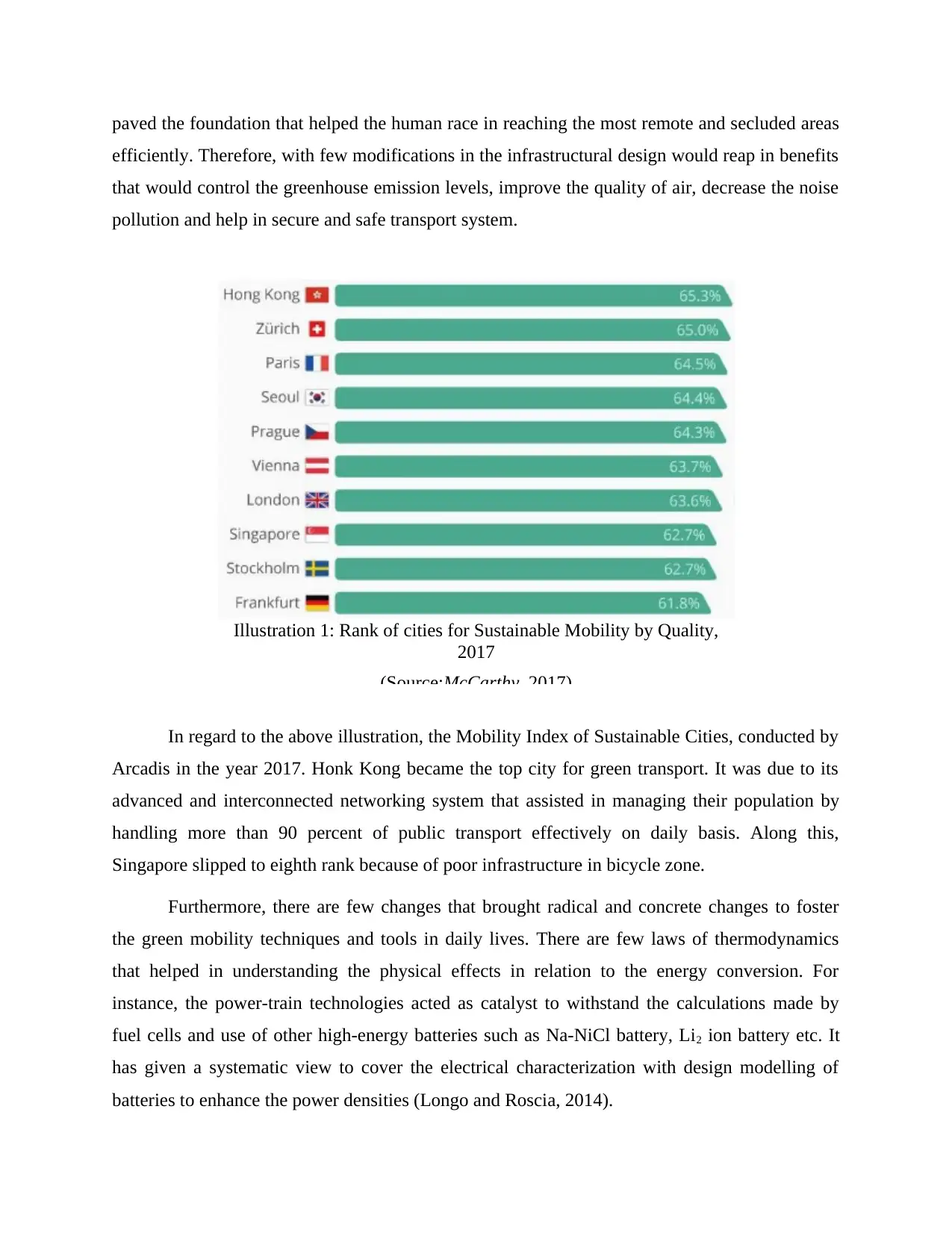
paved the foundation that helped the human race in reaching the most remote and secluded areas
efficiently. Therefore, with few modifications in the infrastructural design would reap in benefits
that would control the greenhouse emission levels, improve the quality of air, decrease the noise
pollution and help in secure and safe transport system.
In regard to the above illustration, the Mobility Index of Sustainable Cities, conducted by
Arcadis in the year 2017. Honk Kong became the top city for green transport. It was due to its
advanced and interconnected networking system that assisted in managing their population by
handling more than 90 percent of public transport effectively on daily basis. Along this,
Singapore slipped to eighth rank because of poor infrastructure in bicycle zone.
Furthermore, there are few changes that brought radical and concrete changes to foster
the green mobility techniques and tools in daily lives. There are few laws of thermodynamics
that helped in understanding the physical effects in relation to the energy conversion. For
instance, the power-train technologies acted as catalyst to withstand the calculations made by
fuel cells and use of other high-energy batteries such as Na-NiCl battery, Li2 ion battery etc. It
has given a systematic view to cover the electrical characterization with design modelling of
batteries to enhance the power densities (Longo and Roscia, 2014).
Illustration 1: Rank of cities for Sustainable Mobility by Quality,
2017
(Source:McCarthy, 2017)
efficiently. Therefore, with few modifications in the infrastructural design would reap in benefits
that would control the greenhouse emission levels, improve the quality of air, decrease the noise
pollution and help in secure and safe transport system.
In regard to the above illustration, the Mobility Index of Sustainable Cities, conducted by
Arcadis in the year 2017. Honk Kong became the top city for green transport. It was due to its
advanced and interconnected networking system that assisted in managing their population by
handling more than 90 percent of public transport effectively on daily basis. Along this,
Singapore slipped to eighth rank because of poor infrastructure in bicycle zone.
Furthermore, there are few changes that brought radical and concrete changes to foster
the green mobility techniques and tools in daily lives. There are few laws of thermodynamics
that helped in understanding the physical effects in relation to the energy conversion. For
instance, the power-train technologies acted as catalyst to withstand the calculations made by
fuel cells and use of other high-energy batteries such as Na-NiCl battery, Li2 ion battery etc. It
has given a systematic view to cover the electrical characterization with design modelling of
batteries to enhance the power densities (Longo and Roscia, 2014).
Illustration 1: Rank of cities for Sustainable Mobility by Quality,
2017
(Source:McCarthy, 2017)
Paraphrase This Document
Need a fresh take? Get an instant paraphrase of this document with our AI Paraphraser
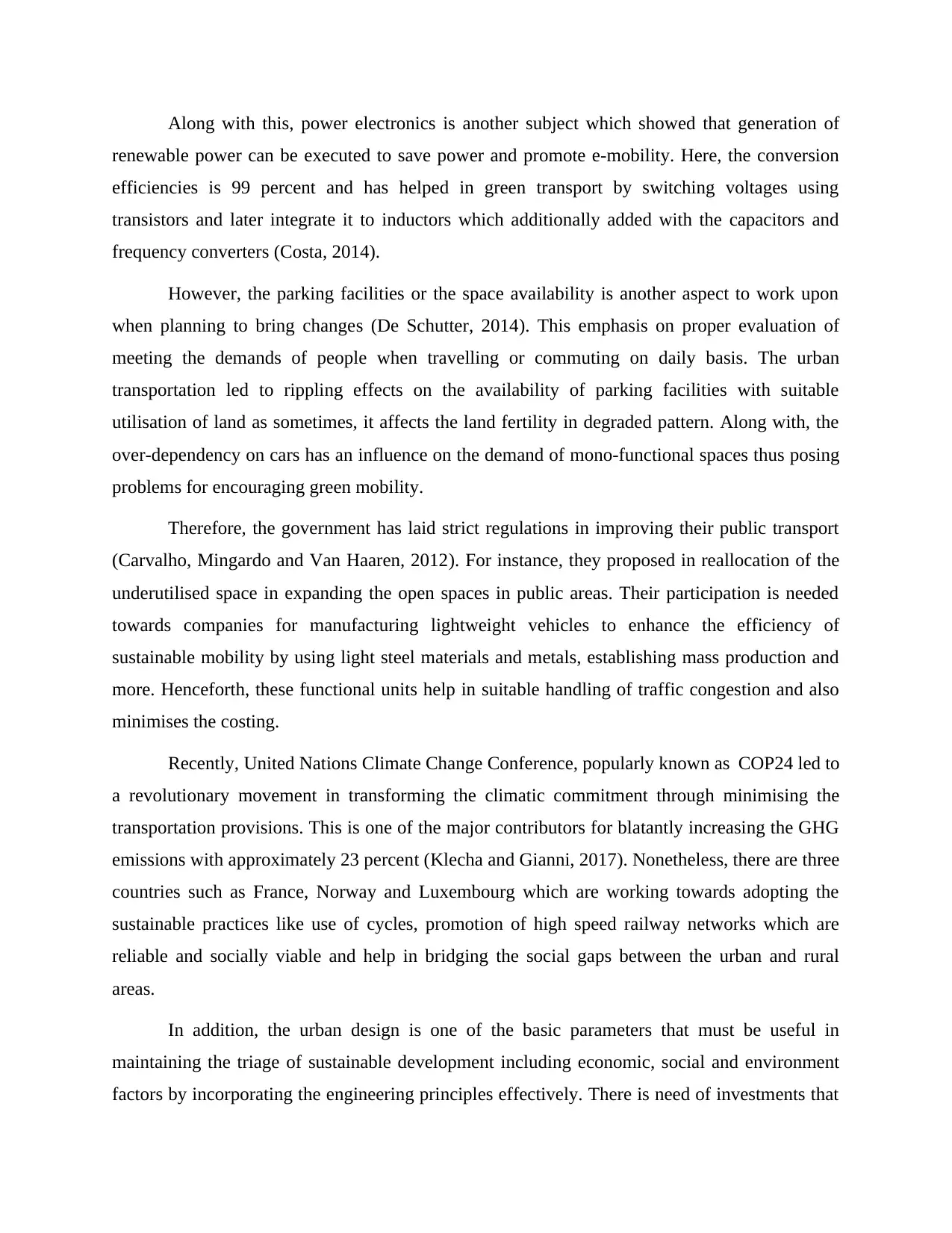
Along with this, power electronics is another subject which showed that generation of
renewable power can be executed to save power and promote e-mobility. Here, the conversion
efficiencies is 99 percent and has helped in green transport by switching voltages using
transistors and later integrate it to inductors which additionally added with the capacitors and
frequency converters (Costa, 2014).
However, the parking facilities or the space availability is another aspect to work upon
when planning to bring changes (De Schutter, 2014). This emphasis on proper evaluation of
meeting the demands of people when travelling or commuting on daily basis. The urban
transportation led to rippling effects on the availability of parking facilities with suitable
utilisation of land as sometimes, it affects the land fertility in degraded pattern. Along with, the
over-dependency on cars has an influence on the demand of mono-functional spaces thus posing
problems for encouraging green mobility.
Therefore, the government has laid strict regulations in improving their public transport
(Carvalho, Mingardo and Van Haaren, 2012). For instance, they proposed in reallocation of the
underutilised space in expanding the open spaces in public areas. Their participation is needed
towards companies for manufacturing lightweight vehicles to enhance the efficiency of
sustainable mobility by using light steel materials and metals, establishing mass production and
more. Henceforth, these functional units help in suitable handling of traffic congestion and also
minimises the costing.
Recently, United Nations Climate Change Conference, popularly known as COP24 led to
a revolutionary movement in transforming the climatic commitment through minimising the
transportation provisions. This is one of the major contributors for blatantly increasing the GHG
emissions with approximately 23 percent (Klecha and Gianni, 2017). Nonetheless, there are three
countries such as France, Norway and Luxembourg which are working towards adopting the
sustainable practices like use of cycles, promotion of high speed railway networks which are
reliable and socially viable and help in bridging the social gaps between the urban and rural
areas.
In addition, the urban design is one of the basic parameters that must be useful in
maintaining the triage of sustainable development including economic, social and environment
factors by incorporating the engineering principles effectively. There is need of investments that
renewable power can be executed to save power and promote e-mobility. Here, the conversion
efficiencies is 99 percent and has helped in green transport by switching voltages using
transistors and later integrate it to inductors which additionally added with the capacitors and
frequency converters (Costa, 2014).
However, the parking facilities or the space availability is another aspect to work upon
when planning to bring changes (De Schutter, 2014). This emphasis on proper evaluation of
meeting the demands of people when travelling or commuting on daily basis. The urban
transportation led to rippling effects on the availability of parking facilities with suitable
utilisation of land as sometimes, it affects the land fertility in degraded pattern. Along with, the
over-dependency on cars has an influence on the demand of mono-functional spaces thus posing
problems for encouraging green mobility.
Therefore, the government has laid strict regulations in improving their public transport
(Carvalho, Mingardo and Van Haaren, 2012). For instance, they proposed in reallocation of the
underutilised space in expanding the open spaces in public areas. Their participation is needed
towards companies for manufacturing lightweight vehicles to enhance the efficiency of
sustainable mobility by using light steel materials and metals, establishing mass production and
more. Henceforth, these functional units help in suitable handling of traffic congestion and also
minimises the costing.
Recently, United Nations Climate Change Conference, popularly known as COP24 led to
a revolutionary movement in transforming the climatic commitment through minimising the
transportation provisions. This is one of the major contributors for blatantly increasing the GHG
emissions with approximately 23 percent (Klecha and Gianni, 2017). Nonetheless, there are three
countries such as France, Norway and Luxembourg which are working towards adopting the
sustainable practices like use of cycles, promotion of high speed railway networks which are
reliable and socially viable and help in bridging the social gaps between the urban and rural
areas.
In addition, the urban design is one of the basic parameters that must be useful in
maintaining the triage of sustainable development including economic, social and environment
factors by incorporating the engineering principles effectively. There is need of investments that
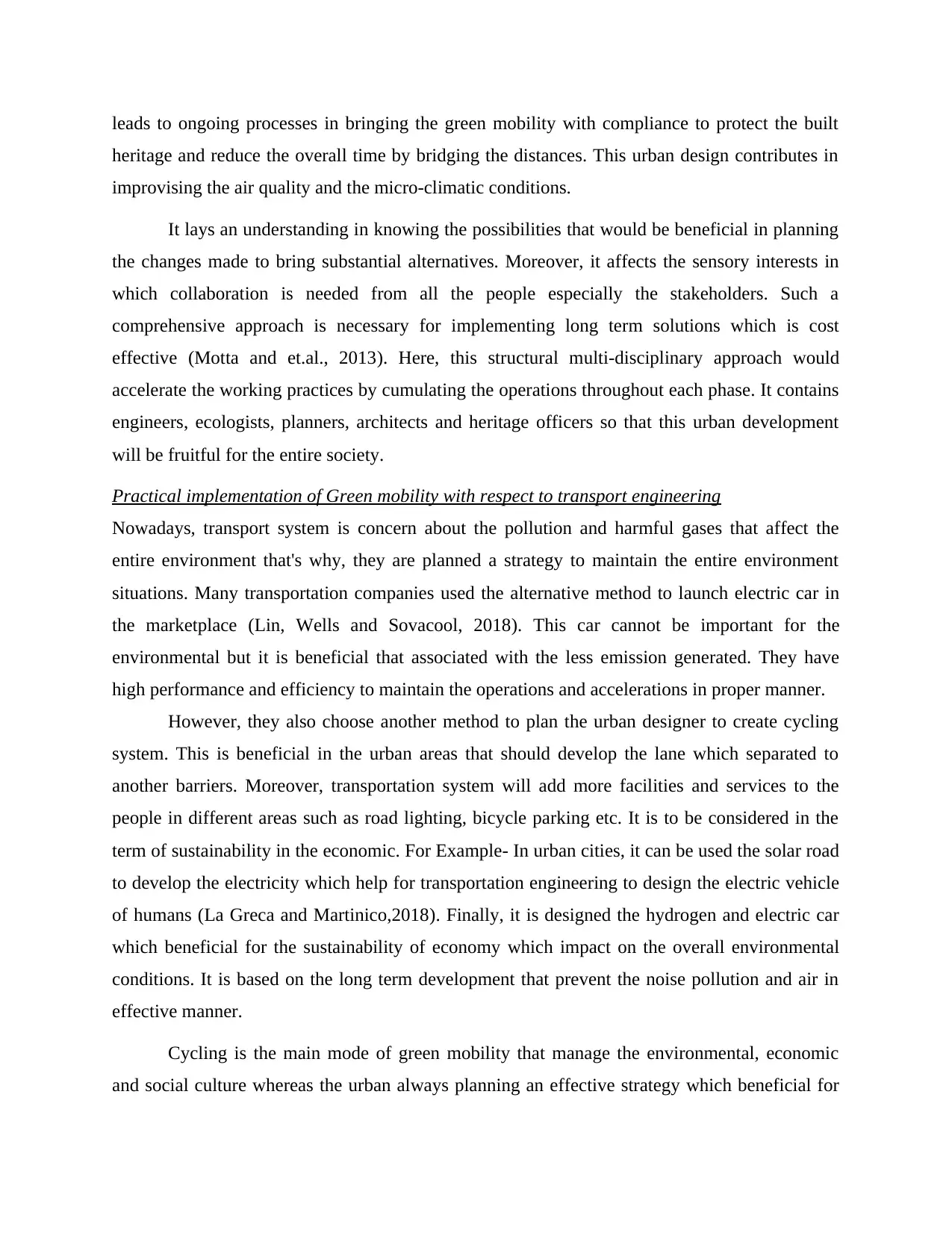
leads to ongoing processes in bringing the green mobility with compliance to protect the built
heritage and reduce the overall time by bridging the distances. This urban design contributes in
improvising the air quality and the micro-climatic conditions.
It lays an understanding in knowing the possibilities that would be beneficial in planning
the changes made to bring substantial alternatives. Moreover, it affects the sensory interests in
which collaboration is needed from all the people especially the stakeholders. Such a
comprehensive approach is necessary for implementing long term solutions which is cost
effective (Motta and et.al., 2013). Here, this structural multi-disciplinary approach would
accelerate the working practices by cumulating the operations throughout each phase. It contains
engineers, ecologists, planners, architects and heritage officers so that this urban development
will be fruitful for the entire society.
Practical implementation of Green mobility with respect to transport engineering
Nowadays, transport system is concern about the pollution and harmful gases that affect the
entire environment that's why, they are planned a strategy to maintain the entire environment
situations. Many transportation companies used the alternative method to launch electric car in
the marketplace (Lin, Wells and Sovacool, 2018). This car cannot be important for the
environmental but it is beneficial that associated with the less emission generated. They have
high performance and efficiency to maintain the operations and accelerations in proper manner.
However, they also choose another method to plan the urban designer to create cycling
system. This is beneficial in the urban areas that should develop the lane which separated to
another barriers. Moreover, transportation system will add more facilities and services to the
people in different areas such as road lighting, bicycle parking etc. It is to be considered in the
term of sustainability in the economic. For Example- In urban cities, it can be used the solar road
to develop the electricity which help for transportation engineering to design the electric vehicle
of humans (La Greca and Martinico,2018). Finally, it is designed the hydrogen and electric car
which beneficial for the sustainability of economy which impact on the overall environmental
conditions. It is based on the long term development that prevent the noise pollution and air in
effective manner.
Cycling is the main mode of green mobility that manage the environmental, economic
and social culture whereas the urban always planning an effective strategy which beneficial for
heritage and reduce the overall time by bridging the distances. This urban design contributes in
improvising the air quality and the micro-climatic conditions.
It lays an understanding in knowing the possibilities that would be beneficial in planning
the changes made to bring substantial alternatives. Moreover, it affects the sensory interests in
which collaboration is needed from all the people especially the stakeholders. Such a
comprehensive approach is necessary for implementing long term solutions which is cost
effective (Motta and et.al., 2013). Here, this structural multi-disciplinary approach would
accelerate the working practices by cumulating the operations throughout each phase. It contains
engineers, ecologists, planners, architects and heritage officers so that this urban development
will be fruitful for the entire society.
Practical implementation of Green mobility with respect to transport engineering
Nowadays, transport system is concern about the pollution and harmful gases that affect the
entire environment that's why, they are planned a strategy to maintain the entire environment
situations. Many transportation companies used the alternative method to launch electric car in
the marketplace (Lin, Wells and Sovacool, 2018). This car cannot be important for the
environmental but it is beneficial that associated with the less emission generated. They have
high performance and efficiency to maintain the operations and accelerations in proper manner.
However, they also choose another method to plan the urban designer to create cycling
system. This is beneficial in the urban areas that should develop the lane which separated to
another barriers. Moreover, transportation system will add more facilities and services to the
people in different areas such as road lighting, bicycle parking etc. It is to be considered in the
term of sustainability in the economic. For Example- In urban cities, it can be used the solar road
to develop the electricity which help for transportation engineering to design the electric vehicle
of humans (La Greca and Martinico,2018). Finally, it is designed the hydrogen and electric car
which beneficial for the sustainability of economy which impact on the overall environmental
conditions. It is based on the long term development that prevent the noise pollution and air in
effective manner.
Cycling is the main mode of green mobility that manage the environmental, economic
and social culture whereas the urban always planning an effective strategy which beneficial for
⊘ This is a preview!⊘
Do you want full access?
Subscribe today to unlock all pages.

Trusted by 1+ million students worldwide
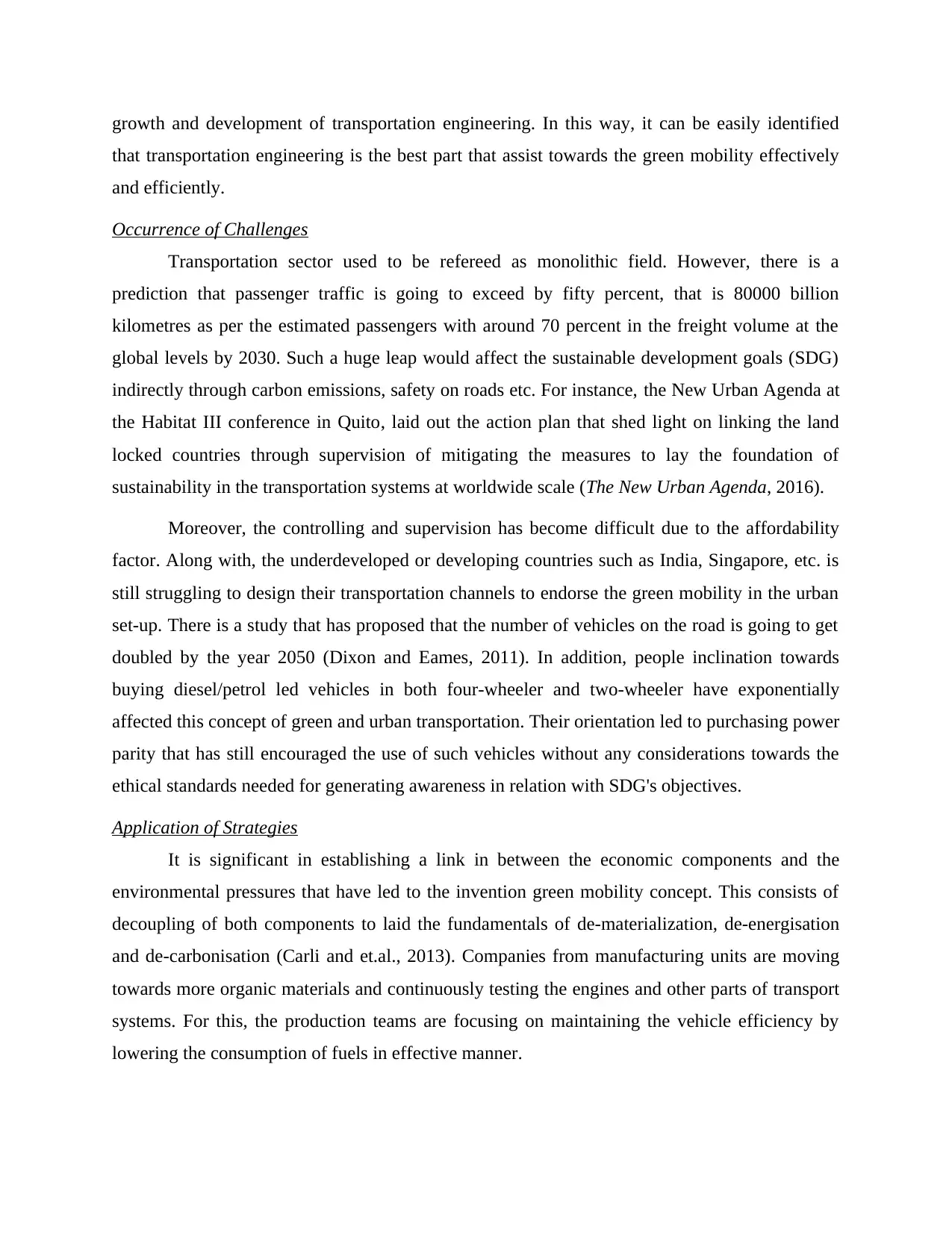
growth and development of transportation engineering. In this way, it can be easily identified
that transportation engineering is the best part that assist towards the green mobility effectively
and efficiently.
Occurrence of Challenges
Transportation sector used to be refereed as monolithic field. However, there is a
prediction that passenger traffic is going to exceed by fifty percent, that is 80000 billion
kilometres as per the estimated passengers with around 70 percent in the freight volume at the
global levels by 2030. Such a huge leap would affect the sustainable development goals (SDG)
indirectly through carbon emissions, safety on roads etc. For instance, the New Urban Agenda at
the Habitat III conference in Quito, laid out the action plan that shed light on linking the land
locked countries through supervision of mitigating the measures to lay the foundation of
sustainability in the transportation systems at worldwide scale (The New Urban Agenda, 2016).
Moreover, the controlling and supervision has become difficult due to the affordability
factor. Along with, the underdeveloped or developing countries such as India, Singapore, etc. is
still struggling to design their transportation channels to endorse the green mobility in the urban
set-up. There is a study that has proposed that the number of vehicles on the road is going to get
doubled by the year 2050 (Dixon and Eames, 2011). In addition, people inclination towards
buying diesel/petrol led vehicles in both four-wheeler and two-wheeler have exponentially
affected this concept of green and urban transportation. Their orientation led to purchasing power
parity that has still encouraged the use of such vehicles without any considerations towards the
ethical standards needed for generating awareness in relation with SDG's objectives.
Application of Strategies
It is significant in establishing a link in between the economic components and the
environmental pressures that have led to the invention green mobility concept. This consists of
decoupling of both components to laid the fundamentals of de-materialization, de-energisation
and de-carbonisation (Carli and et.al., 2013). Companies from manufacturing units are moving
towards more organic materials and continuously testing the engines and other parts of transport
systems. For this, the production teams are focusing on maintaining the vehicle efficiency by
lowering the consumption of fuels in effective manner.
that transportation engineering is the best part that assist towards the green mobility effectively
and efficiently.
Occurrence of Challenges
Transportation sector used to be refereed as monolithic field. However, there is a
prediction that passenger traffic is going to exceed by fifty percent, that is 80000 billion
kilometres as per the estimated passengers with around 70 percent in the freight volume at the
global levels by 2030. Such a huge leap would affect the sustainable development goals (SDG)
indirectly through carbon emissions, safety on roads etc. For instance, the New Urban Agenda at
the Habitat III conference in Quito, laid out the action plan that shed light on linking the land
locked countries through supervision of mitigating the measures to lay the foundation of
sustainability in the transportation systems at worldwide scale (The New Urban Agenda, 2016).
Moreover, the controlling and supervision has become difficult due to the affordability
factor. Along with, the underdeveloped or developing countries such as India, Singapore, etc. is
still struggling to design their transportation channels to endorse the green mobility in the urban
set-up. There is a study that has proposed that the number of vehicles on the road is going to get
doubled by the year 2050 (Dixon and Eames, 2011). In addition, people inclination towards
buying diesel/petrol led vehicles in both four-wheeler and two-wheeler have exponentially
affected this concept of green and urban transportation. Their orientation led to purchasing power
parity that has still encouraged the use of such vehicles without any considerations towards the
ethical standards needed for generating awareness in relation with SDG's objectives.
Application of Strategies
It is significant in establishing a link in between the economic components and the
environmental pressures that have led to the invention green mobility concept. This consists of
decoupling of both components to laid the fundamentals of de-materialization, de-energisation
and de-carbonisation (Carli and et.al., 2013). Companies from manufacturing units are moving
towards more organic materials and continuously testing the engines and other parts of transport
systems. For this, the production teams are focusing on maintaining the vehicle efficiency by
lowering the consumption of fuels in effective manner.
Paraphrase This Document
Need a fresh take? Get an instant paraphrase of this document with our AI Paraphraser
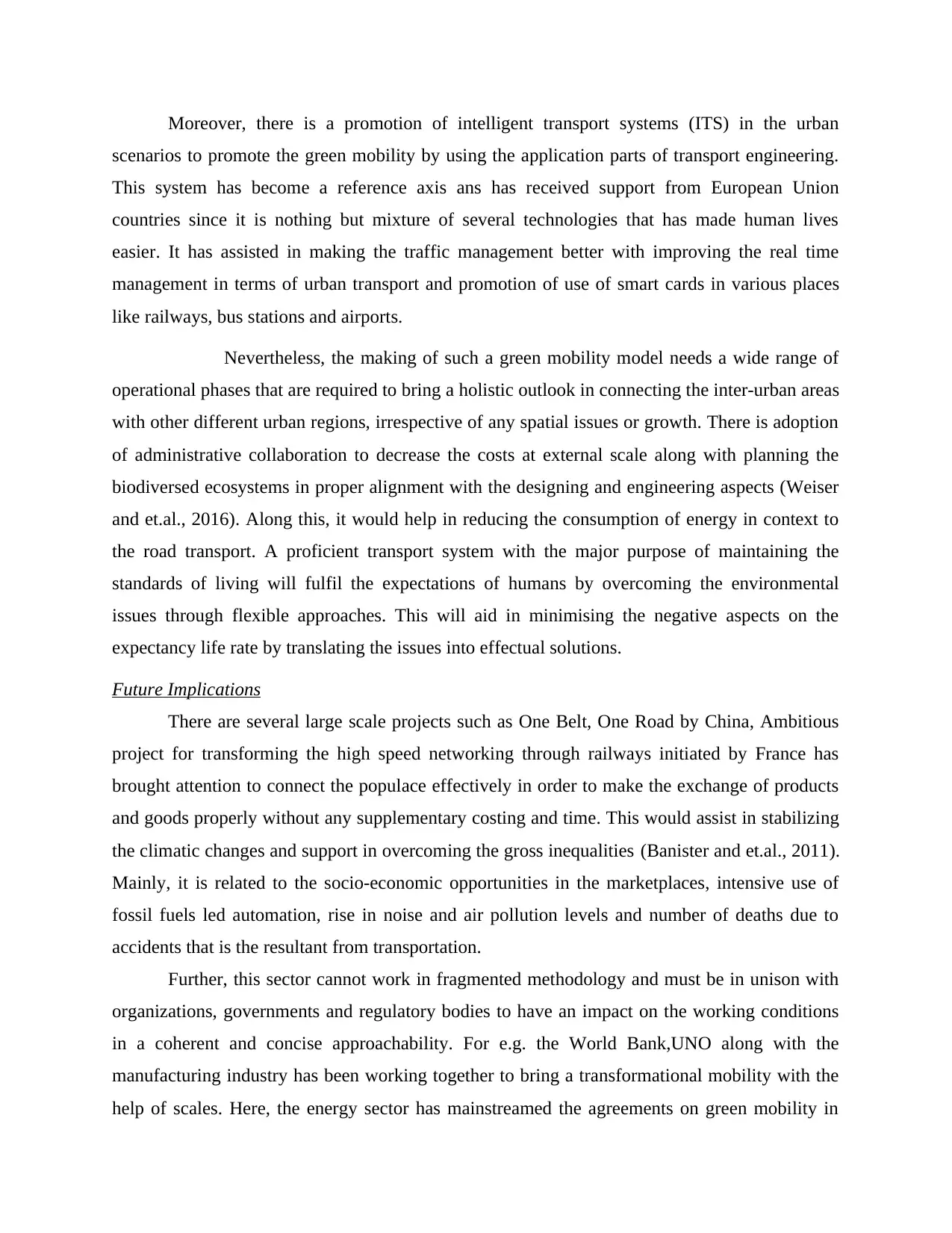
Moreover, there is a promotion of intelligent transport systems (ITS) in the urban
scenarios to promote the green mobility by using the application parts of transport engineering.
This system has become a reference axis ans has received support from European Union
countries since it is nothing but mixture of several technologies that has made human lives
easier. It has assisted in making the traffic management better with improving the real time
management in terms of urban transport and promotion of use of smart cards in various places
like railways, bus stations and airports.
Nevertheless, the making of such a green mobility model needs a wide range of
operational phases that are required to bring a holistic outlook in connecting the inter-urban areas
with other different urban regions, irrespective of any spatial issues or growth. There is adoption
of administrative collaboration to decrease the costs at external scale along with planning the
biodiversed ecosystems in proper alignment with the designing and engineering aspects (Weiser
and et.al., 2016). Along this, it would help in reducing the consumption of energy in context to
the road transport. A proficient transport system with the major purpose of maintaining the
standards of living will fulfil the expectations of humans by overcoming the environmental
issues through flexible approaches. This will aid in minimising the negative aspects on the
expectancy life rate by translating the issues into effectual solutions.
Future Implications
There are several large scale projects such as One Belt, One Road by China, Ambitious
project for transforming the high speed networking through railways initiated by France has
brought attention to connect the populace effectively in order to make the exchange of products
and goods properly without any supplementary costing and time. This would assist in stabilizing
the climatic changes and support in overcoming the gross inequalities (Banister and et.al., 2011).
Mainly, it is related to the socio-economic opportunities in the marketplaces, intensive use of
fossil fuels led automation, rise in noise and air pollution levels and number of deaths due to
accidents that is the resultant from transportation.
Further, this sector cannot work in fragmented methodology and must be in unison with
organizations, governments and regulatory bodies to have an impact on the working conditions
in a coherent and concise approachability. For e.g. the World Bank,UNO along with the
manufacturing industry has been working together to bring a transformational mobility with the
help of scales. Here, the energy sector has mainstreamed the agreements on green mobility in
scenarios to promote the green mobility by using the application parts of transport engineering.
This system has become a reference axis ans has received support from European Union
countries since it is nothing but mixture of several technologies that has made human lives
easier. It has assisted in making the traffic management better with improving the real time
management in terms of urban transport and promotion of use of smart cards in various places
like railways, bus stations and airports.
Nevertheless, the making of such a green mobility model needs a wide range of
operational phases that are required to bring a holistic outlook in connecting the inter-urban areas
with other different urban regions, irrespective of any spatial issues or growth. There is adoption
of administrative collaboration to decrease the costs at external scale along with planning the
biodiversed ecosystems in proper alignment with the designing and engineering aspects (Weiser
and et.al., 2016). Along this, it would help in reducing the consumption of energy in context to
the road transport. A proficient transport system with the major purpose of maintaining the
standards of living will fulfil the expectations of humans by overcoming the environmental
issues through flexible approaches. This will aid in minimising the negative aspects on the
expectancy life rate by translating the issues into effectual solutions.
Future Implications
There are several large scale projects such as One Belt, One Road by China, Ambitious
project for transforming the high speed networking through railways initiated by France has
brought attention to connect the populace effectively in order to make the exchange of products
and goods properly without any supplementary costing and time. This would assist in stabilizing
the climatic changes and support in overcoming the gross inequalities (Banister and et.al., 2011).
Mainly, it is related to the socio-economic opportunities in the marketplaces, intensive use of
fossil fuels led automation, rise in noise and air pollution levels and number of deaths due to
accidents that is the resultant from transportation.
Further, this sector cannot work in fragmented methodology and must be in unison with
organizations, governments and regulatory bodies to have an impact on the working conditions
in a coherent and concise approachability. For e.g. the World Bank,UNO along with the
manufacturing industry has been working together to bring a transformational mobility with the
help of scales. Here, the energy sector has mainstreamed the agreements on green mobility in
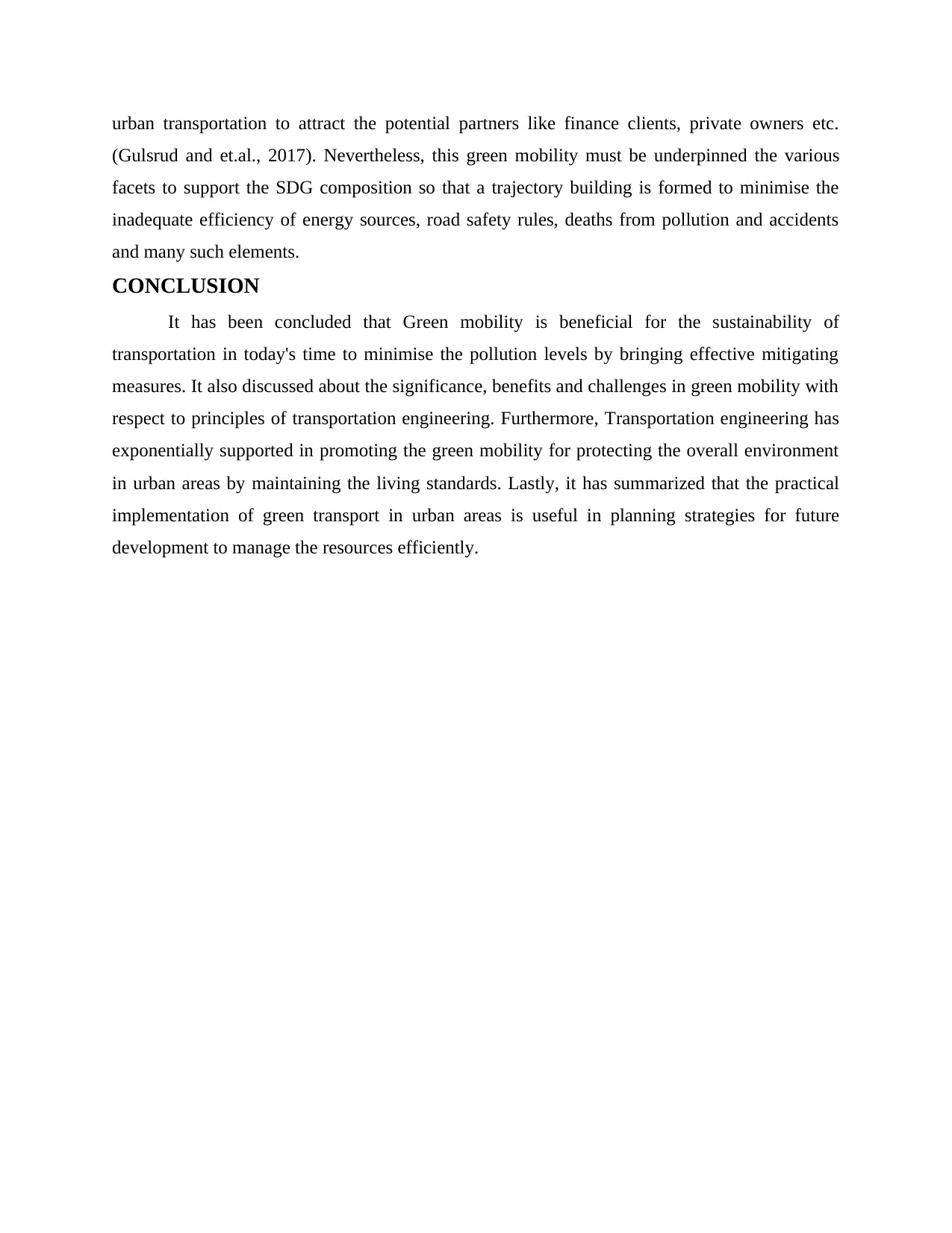
urban transportation to attract the potential partners like finance clients, private owners etc.
(Gulsrud and et.al., 2017). Nevertheless, this green mobility must be underpinned the various
facets to support the SDG composition so that a trajectory building is formed to minimise the
inadequate efficiency of energy sources, road safety rules, deaths from pollution and accidents
and many such elements.
CONCLUSION
It has been concluded that Green mobility is beneficial for the sustainability of
transportation in today's time to minimise the pollution levels by bringing effective mitigating
measures. It also discussed about the significance, benefits and challenges in green mobility with
respect to principles of transportation engineering. Furthermore, Transportation engineering has
exponentially supported in promoting the green mobility for protecting the overall environment
in urban areas by maintaining the living standards. Lastly, it has summarized that the practical
implementation of green transport in urban areas is useful in planning strategies for future
development to manage the resources efficiently.
(Gulsrud and et.al., 2017). Nevertheless, this green mobility must be underpinned the various
facets to support the SDG composition so that a trajectory building is formed to minimise the
inadequate efficiency of energy sources, road safety rules, deaths from pollution and accidents
and many such elements.
CONCLUSION
It has been concluded that Green mobility is beneficial for the sustainability of
transportation in today's time to minimise the pollution levels by bringing effective mitigating
measures. It also discussed about the significance, benefits and challenges in green mobility with
respect to principles of transportation engineering. Furthermore, Transportation engineering has
exponentially supported in promoting the green mobility for protecting the overall environment
in urban areas by maintaining the living standards. Lastly, it has summarized that the practical
implementation of green transport in urban areas is useful in planning strategies for future
development to manage the resources efficiently.
⊘ This is a preview!⊘
Do you want full access?
Subscribe today to unlock all pages.

Trusted by 1+ million students worldwide
1 out of 14
Related Documents
Your All-in-One AI-Powered Toolkit for Academic Success.
+13062052269
info@desklib.com
Available 24*7 on WhatsApp / Email
![[object Object]](/_next/static/media/star-bottom.7253800d.svg)
Unlock your academic potential
Copyright © 2020–2025 A2Z Services. All Rights Reserved. Developed and managed by ZUCOL.





